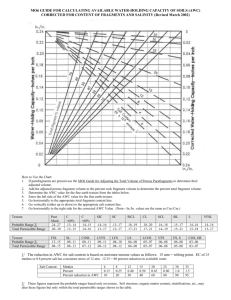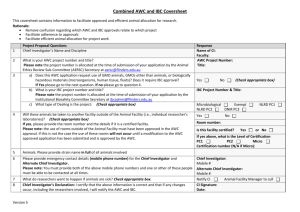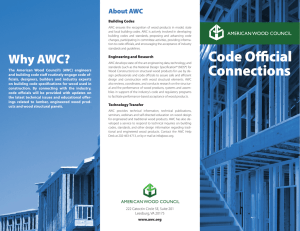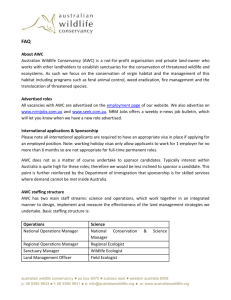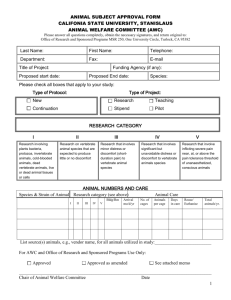Building Knowledge
advertisement
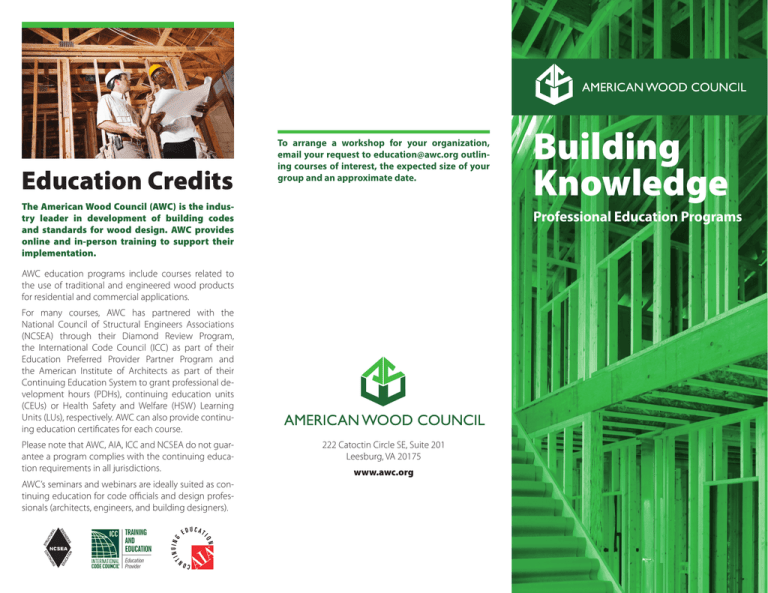
Education Credits To arrange a workshop for your organization, email your request to education@awc.org outlining courses of interest, the expected size of your group and an approximate date. The American Wood Council (AWC) is the industry leader in development of building codes and standards for wood design. AWC provides online and in-person training to support their implementation. Professional Education Programs AWC education programs include courses related to the use of traditional and engineered wood products for residential and commercial applications. For many courses, AWC has partnered with the National Council of Structural Engineers Associations (NCSEA) through their Diamond Review Program, the International Code Council (ICC) as part of their Education Preferred Provider Partner Program and the American Institute of Architects as part of their Continuing Education System to grant professional development hours (PDHs), continuing education units (CEUs) or Health Safety and Welfare (HSW) Learning Units (LUs), respectively. AWC can also provide continuing education certificates for each course. Please note that AWC, AIA, ICC and NCSEA do not guarantee a program complies with the continuing education requirements in all jurisdictions. AWC’s seminars and webinars are ideally suited as continuing education for code officials and design professionals (architects, engineers, and building designers). Building Knowledge 222 Catoctin Circle SE, Suite 201 Leesburg, VA 20175 www.awc.org Choose Your Path to Continuing Education! Why Wood? AWC education programs include courses related to the use of traditional and engineered wood products for residential and commercial applications. AWC offers several education formats to adapt to the needs of an individual or group. More and more attention is being paid to how buildings impact the environment, down to the material choices used in construction. Self-Directed Study Individuals seeking continuing education credit(s) may work at their own pace using AWC’s complimentary self-directed learning via the eCourse webpage under the Education tab. Each course concludes with a series of questions which provides a means for review and measurement for awarding course credit. Live Webinars AWC typically provides monthly webinars with complimentary registration on a wide range of topics related to building codes and standards. Topical Presentations In addition to free online eCourses, AWC can customize live webinars or in-person half- or full-day seminars for organizations or large groups. The following are some available topics: n National Design Specification® (NDS®) for wood construction nSpecial Design Provisions for Wind and Seismic (SDPWS) n Wood Frame Construction Manual (WFCM) A more complete list of topics covered by AWC educational presentations is available under the “education” tab at awc.org. A minimum number of attendees are typically required. A possible scenario for an in-person seminar would include: n AWC providing: n Residential decks n Structural wood framing members n Cross laminated timber (CLT) n Mid-rise wood construction nConnections n Wood meets today’s building codes, allowing its use in a wide range of low- to mid-rise residential and non-residential building types. n Travel, hotel and meal costs for presenter(s) n Wood often costs less and is readily available. n Advertisement of the event on AWC’s website n PDF of presentation n Wood is recognized for its safety and structural performance. n Continuing education units/certificates if requested n Raffle prize of electronic AWC publications n Host providing: n Seminar room rental, including audio/visual setup n Event lunch/breakfast (if applicable) n Event advertising n Attendee contact information to share with AWC n Feedback survey to share with AWC n Significant changes to codes and/or AWC standards nFire protection and heights and areas for wood construction Wood is the perfect green building material because it is renewable and energy efficient. In addition to providing an inviting environment, wood absorbs and sequesters carbon which reduces greenhouse gases. A few more reasons to consider wood in your next project include: To find out more information about AWC’s resources, available topics and course dates, please visit our website — www.awc.org — or email us at education@awc.org n n Wood resists fire through charring of the outer layer, insulating the unburned wood at the core. The flexibility of wood construction makes it an ideal building material for earthquake safety or high wind requirements.
